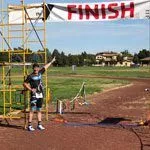Understanding Your 80/20 Endurance Run Strength Plan
Click the image below to watch a video version of this plan overview.
Designed by A.J. Gregg, DC, MS, CSCS, our 80/20 Endurance Run Strength Plans are the perfect complement to our Run Plans. There are 28 plans in all, representing a range of durations and challenge levels. To choose the right plan for you, consider both the length of the Run Plan you’re using and your strength training experience. The table below shows how the various Run Strength Plans align with our Run Plans. The second table offers guidelines on choosing the appropriate level
Step 1: Choose Your Plan Length
| Run Plan | Run Strength Plan |
|---|---|
|
If you’re using one of these Running Plans . . . |
. . . choose a Running Strength Plan of this length: |
| 5K Level 0 5K Level 1 5K Level 2 5K Level 3 |
9 Weeks |
| 10K Level 0 10K Level 1 10K Level 2 10K Level 3 Maintenance Level 0* Maintenance Level 1* Maintenance Level 2* Maintenance Level 3* |
12 Weeks |
| Half Marathon Level 0 Half Marathon Level 1 Half Marathon Level 2 Half Marathon Level 3 |
15 Weeks |
| Marathon Level 0 Marathon Level 1 Marathon Level 2 Marathon Level 3 50-Kilometer Level 0 50-Kilometer Level 1 50-Kilometer Level 2 50-Kilometer Level 3 |
18 Weeks |
| 50-Mile and 100K Level 0 50-Mile and 100K Level 1 50-Mile and 100K Level 2 50-Mile and 100K Level 3 |
19 Weeks |
| 100-Mile Level 0 100-Mile Level 1 100-Mile Level 2 100-Mile Level 3 |
22 Weeks |
*Note that our Maintenance Run Strength Plans are 12 weeks in length but are distinct from our 12-Week Run Strength Plans. We recommend that you select a Maintenance Run Strength Plan if you are using a Run Maintenance Plan and select a 12-Week Run Strength Plan if you’re using a 10K Plan.
Step 2: Choose a Level
| Strength Plan Level | Prerequisites |
|---|---|
| Level 0 | Suitable for all ability levels.
|
| Level 1 | Suitable for athletes with 6-12 months of strength training experience. Before you start, you should be able to hold a Single-Leg Isometric Glute Bridge for 30 seconds on each side, hold aSide Plank for 45 seconds on each side, balance on one foot with your hands on your hips for 60 seconds with eyes open and for 15 seconds with eyes closed, hold a Front Plank for 60 seconds, and complete at least 25 Single-Leg Calf Raises on each side. |
| Level 2 | Suitable for athletes with 1-2 years of strength training experience. Before you start, you should be able to balance on one foot with your hands on your hips for 60 seconds with eyes open and for 30 seconds with eyes closed, complete at least 25 Single-Leg Calf Raises on each side, squat your body weight, hold a Front Plank for 90 seconds, hold a Side Plank 75 seconds, and perform 12 Lateral Step Downs in 60 seconds. |
| Level 3 | Suitable for athletes with at least 2 years of strength training experience. Before you start, you should be able to balance on one foot with your hands on your hips for 60 seconds with eyes open and for 30 seconds with eyes closed, complete at least 25 Single-Leg Calf Raises on each side, squat your body weight, hold a Front Plank for 2 minutes, hold a Side Plank 90 seconds, and perform 20 lateral step downs in 60s. You should also be familiar with running strides. |
Let’s look at an example. Suppose you have more than 1 year and less than 2 years of strength training experience and you are using the Half Marathon Level 2 Plan. In this case, you’ll want to combine your Run Plan with the 15-Week Run Strength Plan Level 2 (assuming you also meet the performance prerequisites for this level). Don’t worry if you discover that the plan you’ve picked is either too hard or too easy. Our Level Guarantee allows you to trade in your plan for a higher- or lower-level plan at no additional cost.
Frequency and Timing
All of our Run Strength Plans feature two workouts per week. The default placement if these workouts is Monday/Thursday. However, it’s okay to move workouts around to fit your schedule. The optimal time to perform a strength workout is on the same day as a harder run, at least two hours after the run is completed. The least optimal time to perform a strength workout is within 18 hours before a harder run, as fatigue generated by the strength workout will interfere with performance in the run that follows. Avoid scheduling strength workouts on consecutive days. Three to four days of separation between strength workouts is preferred.
Warming Up
Before you begin each strength workout:
1. Walk: 5-10 minutes, until warm
2. Praying Squat: 1 minute
3. Body Weight Squat: 3 set of 5 reps with 20 seconds’ rest between sets
4. Kettlebell Swing: 1 set, 6s submax, with light-medium resistance
Now you’re ready to do some strength training!
Workout Structure
Correct execution of your strength workouts requires that you fully understand their structure. Let’s look at a specific example.
Required equipment: barbell, plyo box, resistance band, exercise bench, kettlebells or dumbbells
(3) Half Squat - 3 RIR, 10RM (tempo: 1-2-1-1)
(3) Rolling Plank - 3 RIR (1 rep = 8s/side)
(3) Step-Up with Overhead Press - 4 RIR, (tempo: 1-1-1-1)
(2) Lateral Toe Tap - 4 RIR, light band
(3) Quick Rebounding Heel Raise - 4 RIR (tempo: 140 BPM)
(3) Marching Farmer's Walk - 8s submax
(2) McGill Crunch - 1 RIR or 6 reps
Pick 1 or 2:
(3) Clamshell with Band - 2 RIR (tempo: 1-2-1-1)
(1) Forward Lean - 25 reps (1 rep = 3s hold)
(3) Hip Flexor Knee Drive - 3 RIR (tempo: 2-2-1-2)
(3) Swiss Ball Hamstring Curl* - 3 RIR (tempo: 2-2-1-3)
(3) Copenhagen - 6s submax
(2) Bird Dog - 1 RIR or 9 reps
*Requires stability ball
Required Equipment
The first item in each workout description is a list of required equipment. This list will change from one workout to the next, but in general you will need access to a fully equipped gym to complete your Running Strength Plan. Note that equipment required to perform optional exercises is note separately at the bottom of the workout description in cases where the specific item is not also required by the main portion of the workout. Here’s a complete list of required equipment:
Barbell
Bosu Ball
Cable Weight Stack
Chin-Up Bar
Dumbbells
Exercise Bench
Foam Roller
Kettlebells
Plyometric Box
Resistance Bands
Slide Discs
Stability Ball
Set Sequencing
Exercises that are paired or grouped together represent mini circuits. This means you are to complete one set of each exercise in rotation, continuing to cycle through the paired/grouped exercises until you’ve done the total number of prescribed sets as indicated by the number in parentheses to the left of the exercise name. In the example given, the first two exercises will be done in this fashion:
1 set of Half Squat
1 set of Rolling Plank
1 set of Half Squat
1 set of Rolling Plank
1 set of Half Squat
1 set of Rolling Plank
Each workout has a section of optional exercises. Choose any one or two of these and combine them with the last exercise or pair of exercises of the main portion of the workout to create a mini circuit. In the example given, the last exercise in the main portion is the McGill Crunch. Let’s say you decide to combine this with the Forward Lean and Copenhagen exercises from the list of options. In this case, because the workout calls for two sets of the McGill and three sets each of your selected optional exercises, you will complete the workout in the following manner.
1 set of McGill Crunch
1 set of Forward Lean
1 Set of Copenhagen
1 set of McGill Crunch
1 set of Forward Lean
1 Set of Copenhagen
1 set of Forward Lean
1 Set of Copenhagen
Repetitions/Duration
The information to the immediate right of the exercise name tells you how many repetitions to complete or how long to do the exercise and how much resistance to use, if any. The following terms are used to convey this information:
Reps in Reserve (RIR) is the number of repetitions you have left before technical failure when completing a set. RIR allows you to work within a specific proximity to failure and structure a training block with the aim of increasing either weight or reps each week, thus decreasing RIR. If you find that your RIR and completed reps decrease from set to set within a single workout, reduce your rep count by 1 in the following session. See Table 3 for a comparison between RIR and rating of perceived exertion.
Submax refers to the number of seconds that are left in reserve at the end of each set on isometric holds. Example: If you can hold the movement for a maximum of 15 seconds, then an exercise prescribed as “4s submax” should be held for 11 seconds.
Individual sets of different exercises may be based on time, repetitions, or both. Here are examples of all three:
Time-based set example: “10s submax”
This means you are to hold the position called for in the exercise for as long as you can minus 10 seconds, or 10 seconds short of failure.
Repetitions-based set example: “3 reps in reserve”
This means you are to perform 3 repetitions fewer than the maximum number you are physically able to complete, i.e., stop 3 reps short of failure.
Time- and repetitions-based set example: “10 x 5s each side alternating”
This type of instruction is relevant to exercises such as the Bird Dog that involve alternating movements in two directions or with each leg or arm. In this case you will hold the first position for 5 seconds, then switch sides and hold the second position for 5 seconds, and repeat this sequence a total of 10 times.
In time-based sets, it’s okay to go a little closer to failure in the last set of a given exercise as long as you stop at the point where you begin losing posture or your form starts to deteriorate. Working out in front of a mirror will help you in this regard, but you should also go by feel and self-regulate, making any adjustments needed to ensure the workouts are hard but manageable.
A few exercises included in the plans use the following terms in prescribing intensity: sprint effort, tempo effort, interval effort, and easy effort. When given these instructions, perform the exercise to a level of fatigue that is consistent with your experience in Running workouts of the same type. Table 3 offers additional guidelines for interpreting these intensity prescriptions.
Table 3
| Resistance Training-Specific Rating of Perceived Exertion | ||
|---|---|---|
| Rating | Running Equivalent | Repetitions Short of Maximum |
| 10 | Max Effort/Stride | 0 |
| 9 | 5k-10k race pace | 1 repetition remaining |
| 8 | Hard Tempo Effort | 2 repetitions remaining |
| 7 | Tempo Effort | 3 repetitions remaining |
| 5-6 | Easy/Interval Effort | 4-6 repetitions remaining |
| 3-4 | Aerobic Run | Light effort |
| 1-2 | Fitness Walking/Walking | Little or no effort |
Resistance
Resistance is prescribed in a few different ways, depending on the exercise. For some exercises, the prescribed resistance is based on your individual 10RM, which is the maximum amount of weight you could lift 10 times with good form. If you don’t know your 10RM weight for a given exercise, start with a light weight and perform 10 repetitions. If the last rep does not require a maximal effort, add 10-20 lbs (5-10 kg) and perform another set, continuing until you find your 10RM.
For other exercises, the prescribed resistance is based on bodyweight. For example, if you see “10% BW,” this is telling you to do the exercise using a weight that is equal to 10 percent of your bodyweight.
When no resistance information is given for a particular exercise, it is meant to be done as a bodyweight exercise (i.e., without external resistance). The Rolling Plank, Quick Rebounding Heel Raise, and McGill Crunch exercises in the example workout are all bodyweight movements. However, if you are able to perform more than 15 repetitions of a particular bodyweight exercise, go ahead and add an external load of 5-10% BW to make it more challenging.
For band exercises, you will be instructed to use a light, medium, or heavy band. In the example workout, you are instructed to perform the Lateral Toe Tap exercise with a light band.
Tempo
The information between parentheses to the right of the exercise name tells you how quickly to perform each repetition (i.e., the recommended tempo). Most exercises have four phases: eccentric, transition, concentric, and transition). The eccentric phase is the portion of the exercise where your muscles are lengthening under load. The first transition is the pause between the eccentric and concentric phases. The concentric phase is the portion of the exercise where your muscles are shortening/contracting. Finally, the second transition is the pause between the concentric and eccentric phases.
In the example given, the Half Squat exercise has a 1-2-1-1 tempo. This means you complete the eccentric phase (squatting down) on a 1-count, the first transition (pausing in the squatting position) on a 2-count, and the concentric phase (returning to a full standing position) and second transition (pausing in a full standing position) on a 1-count.
In certain exercises, tempo is prescribed in beats per minute (BPM). In the example workout, you are instructed to perform the Quick Rebounding Heel Raise at a tempo of 140 BPM. These exercises require a metronome. To do them, simply download a metronome app such as Soundbrenner to your smartphone, set it to the prescribed tempo, and perform the exercise in synchronization to the beat.
Video Exercise Demonstrations
In the “pre-activity comments” area of each workout tile, you will find links to video demonstrations of all the exercises included in that workout. Good form is important, so be sure to emulate the form shown in these videos as closely as possible.
If any questions come up as you make your way through your 80/20 Run Strength Plan, contact A.J. Gregg at drajgregg@8020endurance.com.













































































